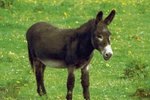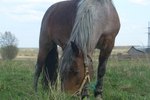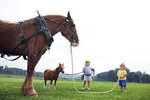Things You'll Need
Breeding muzzle
Lemon juice
Food treats
Tips
Biting is considered an aggressive behavior in some circumstances and a normal behavior in others. Your first step should be to try to identify the reason for the biting behavior so you can evaluate whether action is needed.
Donkeys are not horses. They have some very important physical and behavioral differences. Donkeys respond to slow, quiet approaches and require time to evaluate what is happening around them. Because they are considered stoic animals, you may see fewer initial signs that something is negatively affecting your donkey. While donkeys and horses differ, some negative behaviors can be addressed through methods used to control biting in horses.
Understand basic donkey behaviors. Donkeys are known to stand and face down threats. Biting may be triggered by a perceived threat. Donkeys have blind spots in their vision and dislike having their sensitive ears handled by strangers. A startled animal may bite in self-defense.
Provide company for your animals. Access to other donkeys allows animals to learn social manners. Social interaction helps prevent boredom and acting out. Pecking order is particularly important at feeding time. If you house aggressive donkeys together, leave room for submissive donkeys to retreat. Offer feed in several locations to reduce problems.
Allow your donkeys to demonstrate natural behaviors. Biting behavior is normal when males are introduced to females. Females may bite at males as they become willing to breed. The University of Massachusetts Veterinary and Animal Science Department website suggests you use a breeding muzzle when first introducing males/jacks and females/jennies. The muzzle can be removed after other normal behaviors, such as chasing and kicking, subside. Mothers of foals use biting to correct behaviors in their young, and foals may play-fight with their mothers. Separate aggressive males, if necessary. Males will fight, sometimes viciously, for control over a harem of females. Biting is a part of this behavior.
Ensure that your donkey is receiving proper nutrition, is free of parasites and receives regular exercise or has times when he can experience unconfined movement. These steps will reduce biting due to nutritional deficiency or boredom.
Establish your own dominance. Humans become a part of the social order and must defend their rank at the top. Use non-violent methods, such as control of the animal’s movement, to show that you are in charge. This will help reinforce any messages you send regarding acceptable behavior, such as discipline over biting.
Pay attention to your own actions. Donkeys may bite humans out of fear or pain. Painful incidents that occur during handling, such as when donkeys are harnessed or saddled, may become associated with human contact in the mind of an animal.
Correct negative behaviors immediately as they occur. Methods that do not bring harm, but get an animal’s attention, include a pinch, a growl or a squirt of lemon juice into the mouth. Apply corrections consistently for the best result. Reward good behavior with praise, physical attention or a food treat.
References
- University of Massachusetts Veterinary and Animal Science Department; A Donkey is Not a Horse: The Differences from a Practical Veterinary Standpoint; Stephen R. Purdy, D.V.M.
- Woolshed 1; Animal Behaviour and Welfare: Donkey Part 2; Dr. Clive Dalton; November 2008
- Government of Alberta, Agriculture and Rural Development; The Donkey; November 1990
- University of Pennsylvania, School of Veterinary Medicine; “Applied Animal Behavior Science"; Reproductive Behavior of Donkeys (Equus Asinus); Sue M. McDonnell; 1998
- Pet Place.com; How to Cure a Horse That Bites; Rebecca Sweat
Resources
- Rutgers Equine Science Center; The Basics of Equine Behavior; Carey A. Williams, Ph.D.; July 2004
- Rutgers Equine Sci. Center; Ask the Expert -- Equine Mgmt.; Sarah Ralston, VMD, Ph.D., et al.; 2009
- The Daily Puppy; How to Stop a Horse from Biting & Ear Pinning; Amy Hunter
- Extension.org; How to Break a Mouthy Colt from Biting or Nipping?; August 2006
- Way of the Horse: Horse Help Center Archives
Photo Credits
-
Thinkstock/Comstock/Getty Images





